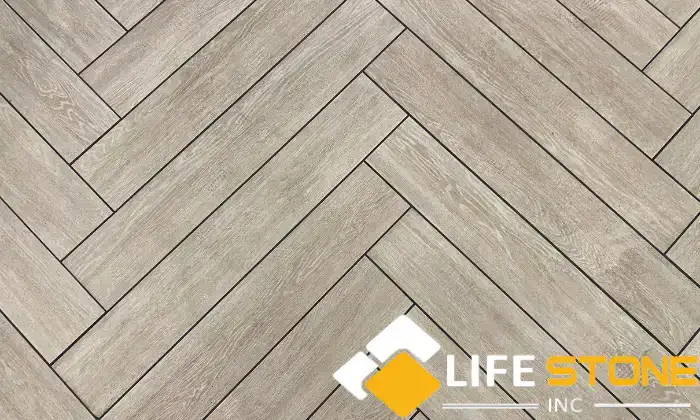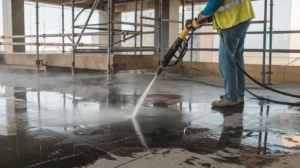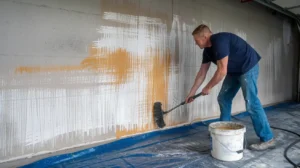How to Clean Concrete Floor effectively is essential to maintaining its durability, visual appeal, and...
Elevate Your Home's Aesthetic with a Herringbone Marble Floor
Marble flooring has long been a popular choice for its timeless beauty and elegance. Its natural variations in color and veining make it a unique and luxurious addition to any home or building. One of the most popular ways to install marble flooring is in a herringbone pattern. This pattern is created by laying rectangular pieces of marble at a 45-degree angle to form a V-shape. The result is a stunning zigzag pattern that adds visual interest and depth to any room.
The herringbone marble floor pattern has been used in architecture and design for centuries, dating back to ancient Rome. It was often used in mosaics and was a popular choice for flooring in grand buildings such as palaces and cathedrals. Today, the herringbone pattern continues to be a popular choice for marble flooring in both modern and traditional settings. Its versatility and timeless appeal make it a great choice for any space. Whether you’re looking to add a touch of elegance to your home or create a grand entrance in a commercial space, a herringbone pattern with marble flooring is a classic and beautiful choice.

Types of Marble for Herringbone Pattern
There are several types of marble that work well in a herringbone pattern. Here are some popular choices:
- White Marble: White marble is a classic choice for a herringbone pattern. It adds a timeless and elegant look to any space. Popular white marbles include Carrara, Calacatta, and Thassos.
- Black Marble: Black marble is a bold and dramatic choice for a herringbone pattern. It adds a sense of luxury and sophistication to any room. Popular black marbles include Nero Marquina and Black Absolute.
- Grey Marble: Grey marble is a versatile choice that works well in both modern and traditional spaces. It can range from light to dark and adds a subtle elegance to any room. Popular grey marbles include Grey Goose and Silver Travertine.
- Beige Marble: Beige marble is a warm and inviting choice for a herringbone pattern. It adds a sense of comfort and relaxation to any space. Popular beige marbles include Crema Marfil and Botticino.
- Green Marble: Green marble is a unique and striking choice for a herringbone pattern. It adds a pop of color and a sense of nature to any room. Popular green marbles include Verde Guatemala and Green Onyx.
Pre-Installation Preparation
Before installing marble flooring in a herringbone pattern, there are several important steps to take to ensure a successful installation. Here are some pre-installation preparation steps to follow:
- Subfloor Assessment: It is important to assess the condition of the subfloor before installing marble flooring. The subfloor must be structurally sound, clean, and level to ensure a successful installation.
- Moisture Testing: It is crucial to test the moisture level of the subfloor and the surrounding environment. High levels of moisture can cause damage to the marble flooring and compromise the adhesive used to install it.
- Surface Preparation: The surface where the marble flooring will be installed must be clean, dry, and free of any debris or contaminants. Any irregularities in the surface must be leveled out to create a smooth and even surface for the marble tiles.
- Layout Planning: Proper layout planning is essential for a successful herringbone pattern installation. The layout should be carefully planned to ensure that the pattern is centered and balanced in the room. The size of the tiles, the spacing between them, and the direction of the pattern should all be considered in the layout planning process.
By taking these pre-installation preparation steps, you can ensure that your marble flooring installation in a herringbone pattern will be a success and will provide years of beauty and durability.
Installation Process of Herringbone Marble Floor
The installation of a herringbone pattern marble floor involves several steps. Here’s an overview of the installation process:
- Adhesive Application: A high-quality adhesive must be used to install marble tiles. The adhesive should be applied to the subfloor using a notched trowel to create a consistent layer.
- Laying the Marble Tiles: The marble tiles should be laid in the herringbone pattern, starting from the center of the room and working outwards. The tiles should be pressed firmly into the adhesive, ensuring that each tile is level with the surrounding tiles.
- Cutting and Trimming: As the installation progresses, some tiles may need to be cut or trimmed to fit around the edges of the room or around obstacles such as doorways. This should be done using a wet saw or tile cutter, and the edges should be smoothed using sandpaper or a grinding stone.
- Grouting: Once the tiles are laid, the gaps between them must be filled with grout. The grout should be applied using a rubber float and worked into the gaps until they are completely filled. Any excess grout should be wiped away with a damp sponge.
- Sealing: Finally, the marble floor should be sealed with a high-quality sealant to protect it from stains and damage. The sealant should be applied in thin, even coats using a clean cloth or brush, and left to dry completely before walking on the floor.
By following these steps, you can create a beautiful and durable herringbone pattern marble floor that will add timeless elegance and sophistication to any room. Contact Us today for a free estimate on your next tile & grout cleaning service!
Maintaining Your Herringbone Marble Floor
Maintaining your herringbone marble floor is important to ensure it stays looking beautiful and in good condition. Here are some tips for maintaining your marble floor:
- Daily Cleaning: Sweeping or vacuuming your marble floor on a daily basis can help remove any dirt or debris that may scratch or damage the surface. Mopping with a damp cloth or mop is also recommended, but avoid using harsh chemicals that can damage the marble.
- Preventive Measures: To prevent scratches and stains on your marble floor, use furniture pads under heavy furniture, and avoid placing hot or acidic items directly on the marble. Clean up any spills immediately to prevent stains from setting in.
- Deep Cleaning: Periodic deep cleaning of your marble floor is important to remove any dirt or stains that may have accumulated over time. Use a pH-neutral cleaner specifically designed for marble floors and follow the manufacturer’s instructions carefully.
- Polishing and Refinishing: Over time, your marble floor may begin to lose its shine and luster. Polishing the surface can help restore its natural beauty. For deeper scratches or damage, refinishing the surface may be necessary. It is recommended to hire a professional for these services.
By following these maintenance tips, you can keep your herringbone marble floor looking beautiful and in good condition for years to come.
Cost of Herringbone Marble Floor
The cost of a herringbone marble floor can vary depending on several factors. Here are some factors that can affect the cost:
- Type of Marble: The cost of the marble used for the flooring can vary depending on the type and quality of the marble.
- Installation: The cost of installation can vary depending on the complexity of the herringbone pattern and the size of the room.
- Subfloor Preparation: If the subfloor requires leveling or repair, this can increase the overall cost of the installation.
- Sealing and Maintenance: The cost of sealing and maintaining the marble floor should also be considered when calculating the overall cost.
When compared to other flooring materials, herringbone marble floors tend to be more expensive due to the cost of the marble itself and the complexity of the installation process. However, marble floors are known for their durability and longevity, making them a worthwhile investment in the long run.
In terms of return on investment, herringbone marble floors can add significant value to a home or property, particularly in high-end or luxury markets. They are a sought-after feature that can make a statement and increase the overall appeal of a property.
Overall, the cost of a herringbone marble floor can be high, but it can also provide a high return on investment in terms of both value and aesthetic appeal.
Pros and Cons of Herringbone Marble Floor
Herringbone marble floors offer a unique and elegant look to any room, but they also come with their own set of advantages and disadvantages. Here are some of the pros and cons of installing a herringbone marble floor:
Advantages:
- Timeless Elegance: The herringbone pattern is a classic design that has been used for centuries, and marble is a timeless material that exudes luxury and sophistication.
- Durability: Marble is a highly durable material that can withstand heavy foot traffic and last for many years with proper care and maintenance.
- Aesthetically Pleasing: Herringbone marble floors have a unique visual appeal that can enhance the overall aesthetic of a room.
- Versatility: Marble is available in a variety of colors and patterns, making it a versatile material that can complement any design style.
Disadvantages:
- Cost: Herringbone marble floors can be more expensive than other flooring materials due to the cost of the marble and the complexity of the installation process.
- Slippery: Marble can be slippery when wet, making it a potential safety hazard.
- Staining: Marble is porous and can be easily stained if spills are not cleaned up immediately. It also requires regular sealing to protect it from stains and damage.
- Scratching: Marble can be scratched by sharp objects, which can detract from its beauty and reduce its lifespan.
Overall, a herringbone marble floor can be a beautiful and durable addition to any home or property, but it is important to weigh the advantages and disadvantages before making a final decision.
Tips for Choosing the Right Herringbone Marble Floor
Choosing the right herringbone marble floor can be a daunting task. Here are some tips to help you choose the right one for your space:
- Color and Veining: Marble comes in a wide range of colors and veining patterns. Consider the color scheme of your room and choose a marble that complements it. Look at samples of different marbles to see which one you prefer.
- Finish and Texture: Marble can be honed for a matte finish, polished for a shiny finish, or textured for a more natural look. Consider the style and decor of your room when choosing a finish and texture.
- Size and Thickness: Herringbone marble tiles can come in different sizes and thicknesses. Consider the size of the room and the overall design when choosing the size of the tiles. Thicker tiles may be more durable but can also be more expensive.
- Budget and Style: Set a budget for your herringbone marble floor and choose a marble that fits within it. Consider the overall style of your home and choose a marble that complements it.
It’s also important to consider the quality of the marble and the reputation of the supplier or installer. Look for reviews and testimonials from previous customers to ensure that you’re getting a quality product and installation. By taking the time to carefully choose the right herringbone marble floor, you can create a beautiful and durable addition to your home.
Hiring a Professional Herringbone Marble Floor Installer
Installing a herringbone marble floor is a complex process that requires skill and expertise. Here are some tips for hiring a professional herringbone marble floor installer:
- Qualifications and Experience: Look for an installer who is licensed, insured, and has experience in installing herringbone marble floors. Ask about their training and certification, as well as their experience with similar projects.
- References and Portfolios: Ask for references and portfolios from previous customers to see examples of their work. Contact the references to ask about their experience with the installer and the quality of their work.
- Contract and Warranty: Make sure to have a written contract that outlines the scope of the work, the timeline, and the payment schedule. Ask about the installer’s warranty for their work and the materials they use.
- Communication: Choose an installer who communicates clearly and effectively throughout the project. They should be responsive to your questions and concerns and keep you updated on the progress of the project.
By hiring a qualified and experienced herringbone marble floor installer, you can ensure that your project is completed on time and to your satisfaction.
Conclusion
A herringbone marble floor is a timeless and luxurious investment that can enhance the beauty and value of your home. By following the tips and recommendations outlined in this guide, you can choose the right herringbone marble floor for your space and ensure that it is installed by a qualified and experienced professional. Remember to consider the color and veining, finish and texture, size and thickness, and budget and style when choosing your herringbone marble floor. It’s also important to properly maintain your floor to ensure its longevity and beauty.
If you’re interested in installing a herringbone marble floor in your home, we recommend contacting a qualified and experienced professional to discuss your options and receive a quote for the project. With the right team and materials, you can create a stunning and durable addition to your home that you will enjoy for years to come.
FAQ's
- How long does it take to install a herringbone marble floor?
- The installation time for a herringbone marble floor depends on several factors, including the size of the space, the complexity of the pattern, and the skill level of the installer. On average, installation can take anywhere from a few days to several weeks.
- Can a herringbone marble floor be installed over radiant heating?
- Yes, herringbone marble floors can be installed over radiant heating systems. However, it’s important to use a high-quality adhesive and ensure that the subfloor is properly prepared.
- Is herringbone marble floor suitable for high-traffic areas?
- Yes, herringbone marble floors can be suitable for high-traffic areas if they are properly installed and maintained. However, it’s important to choose a marble that is durable and has a low porosity.
- What are the most common finishes for herringbone marble floor?
- The most common finishes for herringbone marble floors are polished, honed, and brushed. Polished marble has a glossy finish, honed marble has a matte finish, and brushed marble has a textured finish.
- How often should a herringbone marble floor be sealed?
- The frequency of sealing a herringbone marble floor depends on the type of marble and the level of traffic in the space. On average, it’s recommended to seal the floor every 6 to 12 months.
- Can scratches and stains be removed from herringbone marble floor?
- Yes, scratches and stains can be removed from herringbone marble floors with the right techniques and products. However, it’s important to address them as soon as possible to prevent them from becoming more severe.
- What is the average lifespan of a herringbone marble floor?
- The lifespan of a herringbone marble floor depends on several factors, including the quality of the marble, the level of traffic in the space, and the maintenance of the floor. On average, a well-maintained herringbone marble floor can last for several decades.
- How much does it cost to repair a damaged herringbone marble floor?
- The cost of repairing a damaged herringbone marble floor depends on the extent of the damage and the type of repair needed. On average, repairing a small area can cost a few hundred dollars, while repairing a large area can cost several thousand dollars.
- Is herringbone marble floor a good choice for pet owners?
- Herringbone marble floors can be a good choice for pet owners if they are properly maintained and cleaned. However, it’s important to choose a marble that is durable and has a low porosity.
- How can I enhance the visual impact of my herringbone marble floor?
- You can enhance the visual impact of your herringbone marble floor by choosing a bold or unique color or veining pattern, using a contrasting grout color, adding decorative borders or medallions, or incorporating accent lighting.
Our Services
Our Latest Posts
How to Remove Paint from Concrete
How to Remove Paint from Concrete can be a challenging task, especially when dealing with...
Top 7 Popular Quartz Countertops Colors in 2024
Quartz countertops colors are at the forefront of modern interior design, offering a perfect blend...



